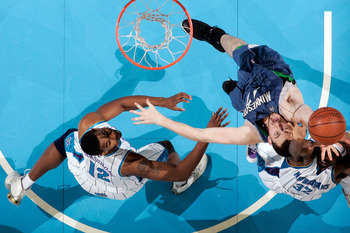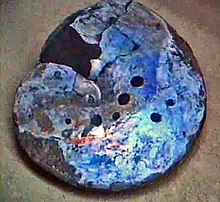Now for most, if not all, people the three subjects- Kevin Love, vampire squid, and ammonites- are not going to be typical water cooler talk. Well thankfully for you and I, I am not most people. So let's start off by talking about my favorite basketball player- Kevin Love. If you are a paleo nerd like myself but don't pay much heed to sports that's ok- I will give you the low down. For myself I have always noticed a continuum between paleontology-biomechanics-functional anatomy-sports science. For Kevin Love his bread and butter has and continues to be his dominance on the glass- rebounding. Now you might assume that height is the predominant attribute of a good rebounder and truth be told being tall does help in rebounding. But a quick perusal of past top NBA rebounders shows that exceptional height is NOT a prerequisite to exceptional rebounding among the elite. Dennis Rodman, arguably the greatest rebounder of all time is 6' 7" and Charles Barkley, the round-mound of rebound, is 6' 6". Kevin Love, although listed at 6'10", is actually closer to a 6' 8" because of lies, damnable lies. Although such heights are impressive to average people, in the NBA with multiple true 7 footers these are not exceptionally tall individuals.
Ok, so if exceptional height is not a prerequisite for exceptional rebounding maybe a guy like Kevin Love does it through jumping ability? Nope, although Love is famous for winning the "white guy award" he is actually an average jumper at his position and his game is more or less under the rim. So how does he pull down a league leading 13.5 rebounds per game?
For Love it is all about anticipation, positioning, and leverage. Anticipate where the ball will bounce off the rim. Despite all the tall, athletic people in the NBA most missed shots are rebounded BELOW the rim and bounce to the side opposite from where they are shot. Knowing the tendency a ball will bounce allows a solid rebounder to anticipate, establish and maintain a zone where he, and only he, can have access to this zone. This is called "boxing out" and is done by using the butt, hips, back and arms to put the opposing rebounder in a detrimental position. At this point getting the rebound is less about being taller or a better jumper but simply carving out a zone of maximum probability of where the ball will bounce. And finally leverage- by keeping your competition on your back you can use the leverage of your own body against theirs to jump up and get the rebound. Despite going against taller and better jumpers Love is a master at this tactic and it allows him to neutralize other players height or athletic ability- as the pic above attests to. Watch the video below for Love versus a sumo wrestler on the box out for a more "sciencey" analysis.
Ok so maybe if you have no interest in sports and you now have a better appreciation for basketball fundamentals- so what does rebounding have to do with vampire squids and ammonites? Well I need you to make a little mental jump with me here. For my purposes here you want to substitute the idea of a rebound, a basketball falling from a high area to a lower area, with biomass falling from a high area to a low area. What is the largest and most continuous biological "rebound" occurring on the earth today? If you guessed it occurs in the ocean you guessed correctly and if you answered the continuous fallout of marine snow across all of the oceans from the photic zone (plants grow) to the aphotic zone (no plants grow) you are right again. One of the more interesting things we are learning about marine snow is that on its way down it is probably ingested and egested several times. This does a couple things; small bits of dead plankton, bacteria, microscopic detritus are made to clump together after being eating. This clumping allows the snow to achieve the mass to actually fall downwards as opposed to remaining neutrally buoyant in the water column. It is only after all the small micro bits have clumped together that they take on the characteristic marine snow behavior serving as a food source for deeper dwelling organisms. Now just as Kevin Love makes a living off of rebounding the basketball, numerous organisms - part of the "deep scattering layer"- make a living off of this motley assortment of dead animals, plants, bacteria, silt, and fecal bits which predictably fall from shallow to deeper waters. And just as Kevin Love must anticipate and establish where to be to collect his rebound- so too must the denizens of the deep scattering layer anticipate and establish themselves in the right spot to collect their biological rebound of deep snow. Numerous organisms take advantage of marine snow as a food, the snow that reaches the sea floor serves as food for various echinoderms, especially brittle stars and sea cucumbers, and other benthic critters.
 |
| MBARI(C) Sea Cucumbers eating dead alga |
An interesting facet of marine snow ecology is that the daily trickle down economics of marine snow was not making much sense in terms of the amount of life seemingly dependent upon it. What researchers are finding out however is that large pulses of biological activity- an algal bloom, salp bloom - create corresponding intense marine snow storms. And it is these intermittent pulses of extreme biological activity, sometimes years apart, that are necessary for the critters in the deep to persist in such numbers.
So not only do critters that live off of marine snow have to be in the right spot to corral it- they have to be there at the right time to take advantage of occasional pulses of intense marine snow storms. Check out the video below here to see what a marine snow storm looks like.
Now one of the more interesting stories to emerge from the deep in the last couple of years was the revelation that the sinister looking vampire squid, Vampyroteuthis infernalis, subsists on marine snow. This strange looking cephalopod is actually very close to the divergence of octopi and squid and is the only cephalopod known to subsist on detrital resources. Please watch the video below from the Monterey Bay Aquarium Research Institute.
The vampire squid reels out a long mucousal string that passively catches marine snow and it reels it in. It lives in the oxygen minimum zone and thus has little predation pressure and no investment in quick locomotory organs. In short, it carved out a great niche as a rebounder of marine snow.
And now for the ammonites. What has long perplexed me is that for many types, including the largest ones, they don't look particularly streamlined or adapted to an active pelagic existence. Feel free to correct me in the comments below but if I wanted to be an active pelagic carnivore or even planktivore, in oceans full of mosasaurs and other beasties I would want a streamlined shell not a round cumbersome shell typical of the largest ammonites.
Ammonites, like modern cephalopods, doubtless exhibited a wide variety of ecologies- from active pelagic predators to benthic hunters and we do know of at least one type of straight shelled ammonite, Baculites, that likely dined on plankton. So let me just throw the idea out there, what if some types of ammonites - especially those large massive types - exploited marine snow a la the vampire squid? There is no reason to suggest marine snow was not a potential resource in Mesozoic oceans. If these putative detritivorous ammonites pursued such an existence they likely cast out a much larger mucousal net to gather snow over a much larger area than vampire squid. Unlike the vampire squid which casts a little string out maybe something similar to the mucousal nets produced by pelagic tunicates was utilized?
 |
| chain of salps. wiki |
Seen as deep sea inhabitants possibly of the deep scattering layer the large septum of ammonites would allow them to change their relative buoyancy and adjust their position in the water column. Remember what I said earlier about being in the right position for that rebound?
If we look at the Mesozoic oceans they are often characterized by less mixing of the ocean layers than modern oceans and, if I can paint with a broad stroke, often times a ubiquitous anoxic zone in which no air breathing life - including ammonites - could survive. So essentially once marine snow sank beneath a certain depth it was out of the game - a carbon sink. In an ocean with an anoxic bottom layer the bottom is essentially pushed up for all intents and purposes as far as life goes. If certain ammonites were consumers of marine snow, maybe they were the last line of defence for snatching that last bit of organic matter before it sank out of the system? And if so, such a recoup of organic material doubtless played a not too subtle role in the Mesozoic ocean carbon balance. And while ammonites with their buoyancy control and putative ability to pump water over their gills like modern cephalopods may have been dominant ecological players down there and largely safe from sharks/predatory fish- that does not mean deep diving air breathing predators did not exploit them. So there may have been an evolutionary advantage to be big, with a thick shell to survive predatory attacks from mosasaurs/pliosaurs etc etc.
The mother Hainosaurus is a 13 meter bruiser of the open ocean. For several years now she has raised successive clutches of young off some deep sea atolls in the eastern Atlantic. Here the 2 meter youngsters, she has a half dozen in tow with her now, face less predators than in near shore waters. Not that much would mess with mother anyways, except maybe another Hainosaurus. The subtropical waters near the surface are largely devoid of life, but the mother knows were to find some shelled calamari a la carte. Experience has taught her that deep below at about 300 meters large ammonites, some over 3 meters in diameter, abound. Occasional convergences of deep ocean currents against the atoll and river runoff from several large oceanic island continents to the east- what will eventually become Europe -provide spectacular but short lived plankton blooms which eventually filter down into the depths to feed the great cephalopod titans of the deep. These shelled beasts are no easy prey. They form massive colonies with interlacing networks of mucousal nets, some nets spanning the length of a basketball court- nets which serve to not only ensnare their diet of deep sea copepods and marine snow- but work as an early detection system for approaching predators. But once the ammonites make a move towards deeper water, they themselves betray their presence to the mosasaur by their disturbance of bioluminescent organisms. But even if a mosasaur latches onto a large ammonite the deal is not done. For the mosasaur the impetus is to get this meal back to the surface as soon as possible- no time to kill and eat down here, just let the pressure change do the killing. For the ammonite the strategy is to keep the struggle in the deep for as long as possible. With an ability to rapidly control buoyancy, entangle predators in mucous and tentacles, sturdy shell, and jet propulsion only the largest and most experienced Hainosaurus actually tackle the mega-ammonites. For mosasaurs that are too small, get too cold, run out of oxygen or try to take on ammonites too large the penalty may be death.
After descending for several minutes the mother Hainosaur becomes neutrally buoyant and finally negatively buoyant, where she starts to sink like a stone. After several more minutes she is over 250 meters deep and begins a more horizontal search to look for ammonites. In these depths she is not looking for the ammonites themselves, but the faint bioluminescent glow of their mucousal nets. It does not take her long to find a colony of several hundred ammonites ranging in size from a couple of centimeters across to almost 3 meters across. To feed her and her clutch she wants one of the big boys though. Even after she finds the colony she does not plunge right into them but waits for one of the ammonites to startle, ditch its net and dive deep. After coursing the colony several times a few ammonites bolt for deep water but it is only after she sees the bioluminescent wake of a particularly large ammonite does she make her attack. The bite is not a kill bite however, she simply wants a firm grip. Even with her massive jaw and gouging teeth these shelled behemoths take too much time and energy to kill and eat at these depths.
Now comes the hard part. From experience the mother knows the tough part is bringing her prey back to the surface. Not only must she fight past the negative buoyancy of her own weight but also the ammonite is doing everything in its power to keep the fight in the deep for as long as possible. And these cephalopods of the deep are witty. First they attempt to smother the mosasaur with their mucous net and if that fails tangle them up with their tentacles. But the mother has seen these moves dozens of times before. In earlier years she panicked and had to abort attacks. But now she knows that the real battle is just getting back up. But the cephalopod tries to thwart the upward movement as well. First by pumping water through its siphon to stay down and then by active pumping of water and gas through its various septums to be as heavy as possible. But again the mother has countered these moves because she has conserved her oxygen and energy for the fight to the surface. By the time the mother is at 50 meters the ammonite is largely devoid of fight from the changes in pressure. Feeling the vibrations from the fight below the clutch of baby Hainosaurs have met the mother at this depth and begin attacking the ammonite, twisting off tentacles like crocs doing death rolls. The mother lets her clutch do the killing and only after she recoups her energy does she start smashing the shell apart at the surface. She makes a note of the electromagnetic signature of this locale for further sounds.
Well like I promised Kevin Love, vampire squid, and ammonites!!!
Cheers!!
Support me on Patreon.
Like antediluvian salad on facebook.
Watch me on Deviantart @NashD1.Subscribe to my youtube channel Duane Nash.
My other blog southlandbeaver.blogspot.





1 comment:
Neat idea, although I don't see how an ammonite would go about building those heavy shells out of the remnants of marine snow.
Perhaps some ammonites were jellyfish specialists?
Post a Comment